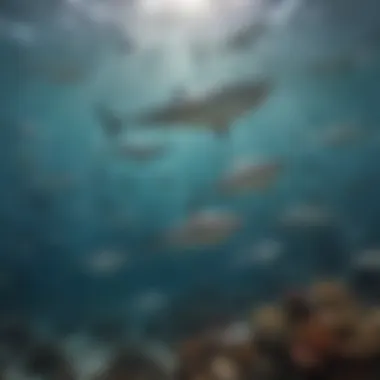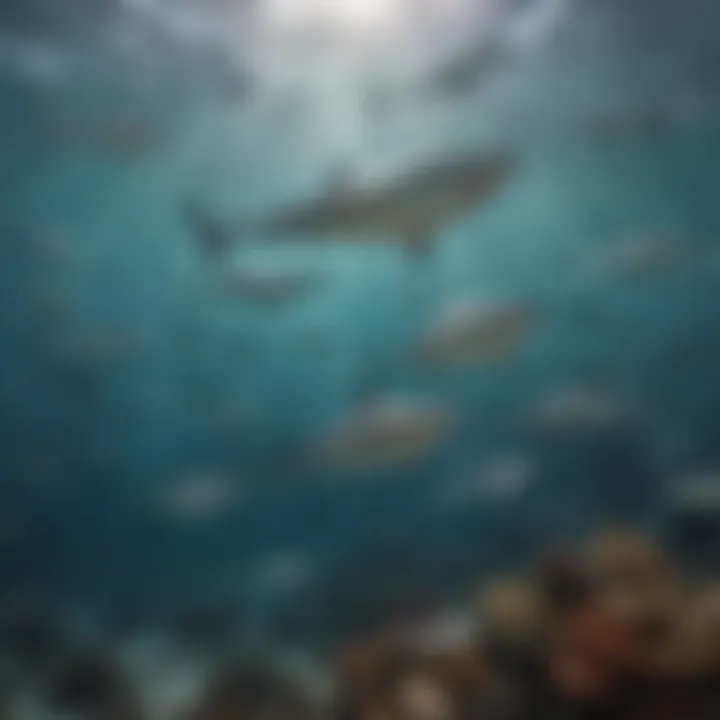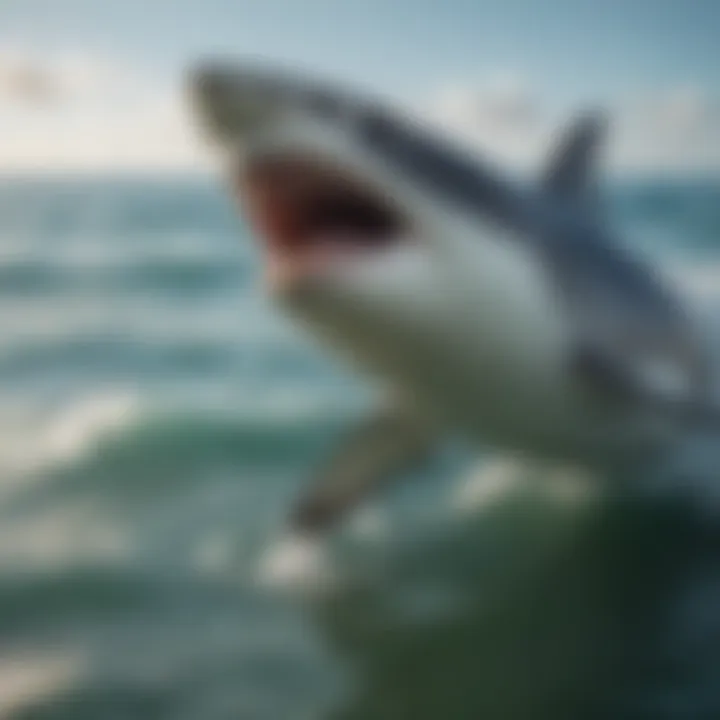In-Depth Understanding of Sharks: Biology and Conservation


Intro
Sharks, often misunderstood creatures of the deep, have intrigued humans for centuries. These apex predators are not just fearsome hunters; they offer essential benefits to marine ecosystems. Their biology, behavior, and conservation are topics worth exploring in depth.
When we think of sharks, images of ferocious beasts probably flicker through our minds. However, what lies beneath that misconception is a complex history and a diverse set of species that contribute significantly to ocean health. From the gentle whale shark to the cunning great white, each shark plays a unique role in marine food webs.
This exploration will walk through various aspects of sharks. We’ll start by examining their biological frameworks, their evolutionary journey, and the importance of them in their habitats. Alongside, we’ll also address the pressing challenges they face due to human impact, and how conservation efforts make a difference. By the end of this article, we aim to foster not only a deeper understanding of these creatures but also a sense of responsibility towards their preservation.
Through this journey, the aim is clear: to shift perceptions from fear to appreciation, demonstrating that sharks deserve a place in our oceans just as much as we do on land.
Intro to Sharks
Understanding sharks goes beyond their fearsome reputation as apex predators of the oceans. The topic of sharks is significant as it bridges biology, ecology, and conservation efforts, shedding light on these ancient creatures that have roamed the seas for more than 400 million years. The exploration of sharks is not simply about their threat to human safety but rather their crucial role in maintaining the balance of marine ecosystems. As athletes, outdoor enthusiasts, and adventurers navigate waters that house these magnificent animals, a deeper understanding of sharks can enhance respect for both the sport and the environment.
A comprehensive approach to shark biology, ecology, and conservation provides benefits not only for sharks but also for the broader marine habitat and communities relying on healthy ocean systems. Furthermore, recognizing the myths surrounding sharks shapes our interaction with them during activities, be it diving, snorkeling, or other marine sports. This understanding is vital, especially in an age when we see increasing conflicts between sharks and humans due to various pressures from overfishing and habitat destruction.
"Sharks are not just fearsome hunters; they play an essential role in the ocean's health and balance."
Overview of Shark Evolution
Sharks belong to a lineage that dates back to the Devonian period, often referred to as the 'Age of Fishes.' This evolutionary journey is marked by various adaptations that have enabled sharks to thrive in diverse marine environments. Unlike bony fish, sharks have a skeleton made of cartilage, which provides flexibility and lighter weight, allowing more agile movements. Over millions of years, sharks have evolved into highly specialized hunters, developing certain traits suitable for survival in various ecological niches. For instance, the Great Hammerhead has a unique head shape that enhances its ability to detect prey, attributing to its hunting success. The diversity of shark species is a reflection of their adaptability and evolutionary success.
The survival of sharks amidst changing environmental conditions is a testament to their evolutionary strengths. As we explore their journey, we should consider how evolutionary pressures such as climate change could impact their future. Understanding evolutionary trends helps researchers predict potential changes in populations and ecological dynamics.
Classification of Sharks
Sharks belong to the class Chondrichthyes and are primarily divided into two major groups: the Elasmobranchii and the Holocephali. The Elasmobranchii group encapsulates a diverse array of species known for their distinct anatomical features, such as their multiple rows of teeth and a variety of body shapes. This includes familiar species like the Great White Shark, which is part of the Lamnidae family known for its efficiency as a predator.
In contrast, Holocephali includes the lesser-known chimeras, which have been around since before dinosaurs walked the Earth. These classifications are critical for understanding their evolutionary heritage and ecological roles.
Some of the major classifications within sharks include:
- Lamniformes: Fast swimmers like the Great White and Mako sharks known for their size and hunting prowess.
- Carcharhiniformes: Also called ground sharks, including species like the Blacktip and Bull sharks, which are often found in coastal waters.
- Orectolobiformes: Carpet sharks, including the Whale Shark, which filters food rather than actively hunting.
By studying the classification, we gain insights into evolution and ecological niches that each species occupies. This knowledge reinforces the imperative for conservation efforts, emphasizing that each species plays a unique role in the vibrant tapestry of marine life.
Shark Anatomy and Physiology
Understanding shark anatomy and physiology is fundamental to grasping their unique role in the marine ecosystem. Sharks are often viewed through a lens of fear and intrigue, but their physical structures reveal much more about their ecological significance and capabilities. By examining specific physiological traits, we can appreciate how these adaptations contribute to their survival and functionality as apex predators.
Unique Physiological Features
Skeleton Composition
Shark skeletons are not made of bone, but rather cartilaginous tissue. This specific aspect of skeleton composition is vital in making them lighter and more agile in the water. Their flexible skeletons allow for astounding maneuverability, which aids in their hunting strategies. The key characteristic of a cartilaginous skeleton is its lower density compared to bony fish, making sharks capable of diving deeper without expending excessive energy.
One unique feature here is the absence of a swim bladder, a structure found in many fish that helps control buoyancy. Instead, sharks rely on their liver, which is filled with oils that help keep them buoyant. This anatomical choice serves as a beneficial adaptation, granting them both speed and agility while also conserving energy, which is particularly vital in their vast ocean habitat.
Skin Structure
The skin of sharks is another remarkable element of their physiology. It is covered with dermal denticles, which are small, tooth-like structures that offer two primary advantages: reducing drag during swimming and protecting against parasites. The key characteristic of shark skin is its rough texture, which helps facilitate smoother swimming.
These dermal denticles allow sharks to glide through water more efficiently, enhancing their hunting prowess. Furthermore, this unique skin structure acts like armor, providing crucial protection that allows them to survive in habitats filled with predation threats. Knowing this, we delve into how these adaptations contribute to their overall physiological efficiency and survival in the wild.
Jaw Mechanics
The jaw mechanics of sharks is a fascinating study. They have a unique jaw design that allows them to project their jaws forward when capturing prey. This capability enables a powerful bite—one of the strongest in the animal kingdom. The key aspect of these jaws is the intricate arrangement of teeth, which are sharp, serrated, and constantly replaced throughout their lives.
A unique feature of shark jaws is the lack of a connection between the upper and lower jaws, allowing for a wider opening and a formidable grasp on prey. This adaptability not only aids in hunting but also enhances their efficiency in consuming a wide variety of marine life.
Sensory Adaptations
Moving beyond physical structures, sensory adaptations play an equally crucial role in a shark's lifestyle. Their ability to sense the world around them greatly impacts their ecological role and hunting abilities.
Lateral Line System
One fascinating aspect of shark physiology is the lateral line system, a sensory organ that detects vibrations and changes in water pressure. This system consists of a series of fluid-filled canals located along the sides of a shark's body. The key characteristic of the lateral line is its sensitivity, allowing sharks to pick up on the slightest movements in the water, which is essential for locating prey or avoiding threats.
The unique feature of this system lies in its effectiveness even in murky waters where visibility is low. This adaptation gives sharks an upper hand in hunting, as they can detect prey even when it is hidden by sediment or in dimly lit environments. It enhances their predation success rate and contributes to their dominance in their ecological niche.
Electroreception
Furthermore, sharks possess electroreception abilities through structures called ampullae of Lorenzini. This sense allows them to detect electric fields generated by other organisms, especially prey. The key characteristic of this mechanism is its precision; sharks can sense electric fields even in the absence of visual cues.


The unique advantage of electroreception is its role in locating prey hidden beneath sand or behind rocks. This sensory adaptation not only assists in hunting but also helps in navigation and social interactions among sharks. Understanding this capability highlights the incredible evolutionary adjustments sharks have made over millions of years.
Vision and Smell
Lastly, shark vision and sense of smell are pivotal in their survival. Sharks have acute eyesight, even in dark waters. They have a reflective layer behind the retina called the tapetum lucidum, enhancing their ability to see in low light conditions. The key aspect of their vision is the capacity to detect motion over vast distances, making them proficient hunters.
Moreover, sharks have an impressive sense of smell; they can detect blood in concentrations as low as one part per million. This unique feature makes them one of the most effective predators in the ocean. The combination of these senses allows sharks to be efficient hunters, showcasing the importance of sensory adaptations in their anatomy.
"Every structural feature of sharks reflects their evolutionary journey, equipping them for survival in diverse marine environments."
Overall, diving into the anatomy and physiology of sharks reveals how perfectly adapted they are to their environments. An appreciation for these attributes deepens our understanding of their ecological roles and the significance of their conservation in our oceans.
Diverse Shark Species
Diversity among shark species is not merely a matter of numbers; it reflects the tremendous evolutionary adaptations these creatures have made to inhabit various niches within marine environments. Understanding this diversity helps illuminate the ecological roles that sharks play and the significance of their preservation in the ocean. Each species brings unique traits and behaviors to the ecosystem, which influences everything from prey dynamics to habitat health. This section dives into prominent shark families and their distinctive characteristics, focusing on their habitats and adaptations.
Major Families of Sharks
Great White Shark
The Great White Shark, known scientifically as Carcharodon carcharias, is perhaps the most recognizable shark in popular culture. Renowned for its size, this apex predator can reach lengths of up to 20 feet while weighing over 4,000 pounds. What sets this shark apart is its powerful body and capability to burst out of the water to catch prey, a hunting style termed breaching. This is a pivotal aspect to the great white's contribution to marine ecosystems as it maintains the balance of various marine populations.
The key characteristics of the Great White Shark include its robust jaws lined with serrated teeth, perfect for capturing seals and larger prey. This ability not only showcases the species' adaptability but also underscores its role in regulating marine life. A distinctive feature is the Great White's exceptional sense of smell, which allows it to detect blood in the water from miles away. This hunting mechanism can be both an advantage, enabling efficient feeding, and a disadvantage, as it has led to hits in coastal areas where human activity is prevalent.
Tiger Shark
Next up is the Tiger Shark, scientifically known as Galeocerdo cuvier. This shark is easily identifiable thanks to the distinctive dark stripes along its body which resemble those of a tiger, hence the name. Their penchant for a diverse diet, dubbed the "garbage eaters" of the sea, reveals their versatility—one day preying on fish, the next consuming sea turtles or even non-food items like license plates. This varied diet contributes significantly to their ecological role as they help maintain population balance in various species.
The key characteristic of the Tiger Shark is its ability to thrive in both coastal waters and the open ocean, which makes it a unique focal point in discussions about adaptability among shark species. A unique feature is its large, curved teeth designed for grasping and tearing prey, illustrating evolutionary solutions to feeding challenges. However, this adaptability can sometimes put Tiger Sharks in conflict with fishermen or other sharks, leading to potential risks in different environments.
Whale Shark
Finally, we have the Whale Shark, or Rhincodon typus, the largest fish species on the planet, often exceeding lengths of 40 feet. Despite its vast size, the Whale Shark feeds primarily on plankton, showcasing its gentle nature. Its immense mouth can filter large volumes of water to capture small prey, contributing to its reputation as a harmless giant. This characteristic makes it an interesting model for studying filter-feeding mechanisms, which play essential roles in nutrient cycling within marine ecosystems.
The key characteristic of the Whale Shark's behavior is its slow swimming and surface feeding habits, which add to its allure in marine tourism—where divers and snorkelers seek encounters with these remarkable beings. A unique feature of this species includes its distinct pattern of spots, akin to fingerprints, which helps in individual identification. The gentle disposition can pose, however, challenges, particularly in areas where human activities such as fishing and boat traffic are prevalent, potentially threatening their populations.
Habitat Distribution
Coastal vs. Oceanic Species
Examining sharks through the lens of habitat distribution reveals fascinating insights into their ecological roles. Sharks inhabit a range of environments, from shallow coastal waters to the deep ocean, allowing them to fulfil diverse ecological niches. Sharks in coastal regions, like the Great White or Tiger Shark, often engage in breeding and feeding near the shorelines where prey is abundant. This characteristic makes them critical in maintaining the health of marine ecosystems, as they influence the population dynamics of various fish species.
Coastal species are often more vulnerable to human activities because of their proximity to shorelines. This beneficial aspect encourages active fisheries management and conservation efforts; however, it also exposes them to increased risks from pollution and habitat loss.
Deep-Sea Adaptations
In contrast, deep-sea shark species have developed remarkable adaptations to survive in the extreme conditions of the ocean's depths. Their darker skin provides camouflage, and many exhibit bioluminescence, allowing them to navigate the murky waters. These adaptations play a crucial role in their ecological interactions, as they can inhabit regions where few predators or competitors exist.
The unique feature of these species is their ability to withstand high pressure and low temperatures, which is a significant adaptation for deep-sea living. While this makes them a resilient group, it also means they often have slower reproduction rates, which can contribute to vulnerability in the face of environmental changes. Understanding the varying habitat preferences of shark species is vital for conservation strategies aimed at preserving the rich diversity of this ancient lineage.
Behavior and Ecology
Understanding the behavior and ecology of sharks provides crucial insight into their role within marine environments. This section sheds light on their intricate feeding patterns and social structures, illustrating not only how they interact with their prey but also how they communicate and coexist within their habitats. Gaining knowledge on these aspects not only emphasizes the conservation needs of these apex predators but also enhances our appreciation for their influence on the marine ecosystem.
Feeding Patterns
Prey and Predation Dynamics
The dynamics of prey and predation in sharks is a fascinating area of study. It delves into how these powerful hunters interact with their environment and the species around them. Sharks primarily prey on fish, squid, and even marine mammals. Depending on the species, their hunting strategies vary widely.
The key characteristic of this relationship is adaptability. Different shark species have evolved unique methods of tackling their prey, from the swift, ambush tactics of the Great White to the filter-feeding method of the whale shark. This behavioral diversity not only highlights their evolutionary success but serves a larger ecological purpose by regulating prey populations, maintaining the balance within marine ecosystems.
One distinctive feature of these dynamics is aggregation behavior. Certain sharks, like the hammerhead, may hunt in groups to corner prey more effectively—a behavior that leads to a higher hunting success rate. However, this also points out potential disadvantages; a group could attract more competition or even predation by other larger marine animals.
Feeding Strategies
Feeding strategies in sharks reflect their adaptability to different environments and prey availability. They utilize various methods, including active hunting, scavenging, and even ambushing. Each strategy plays a crucial role in their survival and efficiency in energy consumption.
A notable characteristic of feeding strategies is specialization. Some species, like the nurse shark, have evolved to rely on sucking prey from the seafloor, while others, like the shortfin mako, utilize high-speed bursts to chase down fast-moving fish. This specialization is beneficial as it allows sharks to occupy specific niches in the ecosystem, enhancing their survival.
However, it also imposes restrictions; sharks that are too specialized may struggle to adapt to changes in their environment or food supply. For instance, with declining fish stocks due to overfishing, specialized feeders can face significant challenges.
Social Structures
Solitary vs. Social Species


Social structures among sharks vary greatly. Some species are solitary, while others exhibit social behavior, forging complex interactions with their peers. This distinction significantly impacts their entire ecology. Solitary sharks like the great white often stake out large territories and rely heavily on individual hunting skills. In contrast, species like lemon sharks display schooling behavior, which enhances their hunting effectiveness and provides safety in numbers.
The defining trait of these social structures is behavioural flexibility. Some species can switch between solitary and social behaviors based on environmental cues or food availability. This adaptability not only aids in finding food but also in avoiding predation. However, while social species may gain some advantages, being in a group can also lead to heightened competition for resources.
Communication Methods
Sharks utilize several communication methods, both subtle and pronounced, to interact with one another. Behavior such as body language, especially display of dorsal fins, and sensory cues play vital roles in their interactions. These methods are essential for social species as they navigate their complex environments and relationships.
The key aspect of communication methods is chemical signaling. Sharks possess an acute sense of smell, which allows them to detect pheromones from peers and prey from great distances. This ability to communicate chemically is a tremendous advantage, particularly in murky waters, where visibility is limited. However, communication can have disadvantages too; it may signal vulnerability to other predators or rival sharks.
Important Note: The behaviors and adaptations of sharks are deep-rooted and inform both their ecological roles and their evolutionary paths. Understanding these can promote effective conservation strategies and better coexistence between sharks and humans.
As we dive deeper into the intricate world of sharks, it becomes clear that their behavior and ecology are directly linked to the health of marine ecosystems. \ Through studying these patterns, we can appreciate the multifaceted relationships that sharks maintain both within their species and with other marine life.
The Role of Sharks in Marine Ecosystems
Sharks are often considered the rulers of the ocean, not just for their size and power, but for the crucial roles they play in maintaining the health of marine ecosystems. As apex predators, they influence the compositions of the oceanic food webs and help balance the populations of various marine species. Through detailed inspection, we can appreciate how sharks uphold ecological integrity, affect biodiversity, and sustain habitats essential to countless marine organisms.
Apex Predators and Their Impact
Regulating Prey Populations
Sharks stand at the top of the food chain and significantly shape the ecosystem's structure. The primary way they exert this influence is by regulating prey populations.
When populations of herbivorous fish and smaller predators are kept in check, they prevent overgrazing and overpopulation, effectively helping to maintain healthy habitats like seagrass beds and coral reefs. This bio-regulatory effect ensures that resources are not depleted, which is vital for the survival of various marine life forms.
Moreover, the predation done by sharks contributes to the natural selection process, favoring the survival of the fittest fish in the ecosystem. This characteristic keeps prey species diverse and resilient, which is a big plus for marine variety. However, if shark populations dwindle due to overfishing or habitat loss, you can bet that immediate and long-lasting changes are going to ripple throughout the aquatic system, potentially leading to a collapse of certain species.
Biodiversity Maintenance
The influence of sharks extends far beyond mere population control; they play an overarching role in biodiversity maintenance. The unique position they hold allows them to interact with and balance various species across the food web. With their predatory nature, they help stabilize the populations of species that, if left unchecked, might dominate a habitat and lead to a decline in diversity.
Biodiversity, in turn, is the bedrock of effective ecosystems. It promotes resilience, allowing marine ecosystems to adapt to changes and disturbances. Notably, diverse ecosystems can recover from environmental stressors, such as climate change or pollution, more swiftly than their less diverse counterparts. The presence of sharks thus offers a safeguard for these intricate webs of life. Yet, the invalidation of this role poses potential disadvantages, threatening the intricate connections that exist beneath the waves.
Sharks and Coral Reefs
Importance for Reef Health
Sharks are also essential to maintaining the health of coral reefs, one of Earth’s most vibrant ecosystems. Their predation on herbivores and smaller predators directly impacts the reef health. Without sharks to regulate their numbers, smaller grazers may multiply excessively, thus damaging the delicate balance of coral communities.
Healthy reefs are not only home to countless marine species but also serve as crucial barriers against coastal erosion and climate impacts. By controlling prey populations, sharks indirectly support coral growth and resilience. This characteristic of sharks makes them natural allies in preserving these marine treasures, and the loss of their presence can lead to a collapse of the entire reef ecosystem.
Interconnectedness of Marine Life
The interconnectedness of marine life further showcases the importance of sharks. They are not just isolated predators; their presence affects a whole spectrum of organisms.
By influencing the behavior and population dynamics of other marine animals, such as turtles and smaller fish, sharks help create a balance that promotes a thriving marine environment. This interconnectedness emphasizes that sharks are but one piece of a larger puzzle, and their role is vital for the well-being of the ecosystem. However, as they disappear, so does the unique balance that sustains healthy oceans. Every creature, no matter how small, has a part to play, and sharks help connect all those dots.
"In every ecosystem, there is a role worth protecting, and for marine environments, that role is often filled by sharks. They are not just fearsome predators, but vital guardians of balance in the ocean."
Conservation Issues
Conservation issues regarding sharks are more than just matters of biodiversity; they carry profound implications for the health of marine ecosystems and human livelihood. Sharks have been swimming in our oceans for over 400 million years, yet today many species are teetering on the brink of extinction. Understanding the importance of conservation allows us to address the pressing threats sharks face, ultimately benefiting not only these magnificent creatures but the entire marine environment.
Threats to Shark Populations
Overfishing
Overfishing poses a formidable threat to shark populations globally. The demand for shark fins, meat, and other body parts drives unsustainable fishing practices, often leading to the drastic decline of various shark species. This issue isn't just about the fishers making a profit; it touches on the delicate balance of marine ecosystems. Once top predators like sharks are removed, the ramifications echo throughout the food web, potentially leading to the collapse of entire fish populations.
The distinct nature of overfishing is that it often occurs indiscriminately. Since sharks typically grow slowly and have long gestation periods, their populations struggle to recover. This characteristic makes overfishing a pivotal point of concern in this article. It directly affects the urgency with which we need to act in conservation efforts.
Habitat Loss
Habitat loss significantly impacts sharks, particularly as coastal regions are developed. Mangroves and coral reefs, critical for many species' breeding and feeding, are being degraded or destroyed. When sharks lose their habitats, they not only face the challenge of finding food but are also exposed to increased mortality rates due to environmental stressors. The erosion of these habitats is not just detrimental for sharks; it disrupts entire marine ecosystems.
The key characteristic of habitat loss is its multifaceted nature. It’s not merely about physical space being taken away but about vital environments disappearing, leading to broader ecological damage. Understanding this helps to underscore why habitat conservation is integral in any comprehensive discussion about sharks and their future.
Climate Change
Climate change is reshaping our oceans, and sharks are no exception. Rising water temperatures and ocean acidification alter prey availability and breeding grounds, greatly impacting shark species. Though sharks are known for their adaptability, the rapid changes we witness today often outpace their ability to adjust.
The concern here is the interconnectedness of climate change and shark survival. A warmer ocean can lead to shifts in migratory patterns, affecting food chains and predator-prey relationships. Through understanding the migration patterns and breeding cycles influenced by climate, we can grasp the significance of shark conservation more comprehensively.
Conservation Efforts
International Agreements
International agreements play a central role in the protection of sharks and their habitats. Treaties like the Convention on International Trade in Endangered Species of Wild Fauna and Flora (CITES) help regulate international trade of shark species threatened with extinction. Such agreements are foundational in setting the stage for global cooperation against illegal fishing. They also send a strong signal about the need for shared responsibility in the fight against shark decline.
The strength of international agreements lies in their ability to unify countries around a common goal. By developing legally binding commitments, nations can prioritize the protection of these vital species. Understanding the dynamics of these agreements provides context for why international policy is crucial in the broader narrative around shark conservation.
Community-Based Initiatives


Community-based initiatives represent a grassroots approach to shark conservation, emphasizing local involvement and stewardship. These programs often hinge on educating communities about the ecological and economic importance of sharks. Involving locals can lead to more effective management practices, forging a connection between the preservation of sharks and the livelihoods of coastal populations.
What makes community-based initiatives particularly noteworthy is their adaptability. These programs can cater to local cultures and ecosystems, fostering a sense of ownership that can enhance their effectiveness. By fostering awareness and passion within communities, these initiatives not only contribute to shark conservation, but also enrich local economies through sustainable practices.
"Understanding the delicate balance in marine ecosystems, where sharks hold a pivotal role, is key to crafting effective conservation strategies."
Through addressing these conservation issues and emphasizing their significance, we can shed light on the path forward. It’s essential to support international agreements and community-based initiatives, while also ensuring that overfishing, habitat loss, and climate change are tackled comprehensively. By fostering a deeper understanding of sharks’ ecological roles, we can work towards a future that allows both marine life and human communities to thrive.
Sharks in Culture and Society
Sharks have held a prominent place in human culture—this isn't just about their predatory reputation or their physical presence in the ocean. Understanding sharks in culture and society allows for a glimpse into the complex relationship between humans and these creatures. Myths, fears, and even a degree of fascination surround sharks, shaping public perception and influencing conservation efforts.
Myths and Misunderstandings
Media Portrayals
Often, the imagery and stories shared in movies or social media drastically shape people’s understanding of sharks. Take the film Jaws, for example. It brought about a sensation that cast sharks as relentless monsters. The shocking visual of a great white terrorizing a beach town took the world by storm, compelling viewers to associate excitement with fear. The key characteristic of media portrayals like this is the dramatization of shark behavior, leading to misconceptions.
The allure of thrilling narratives attracts audiences, yet it can spread misinformation. Documentaries tend to offer deeper insights, but they often don't capture the sensational appeal that brings in large viewerships. While scary stories grab attention, they overlook the ecological role sharks play, vital for maintaining the balance in marine life.
"Sharks are natural predators, not monsters. Their survival ensures the health of ocean ecosystems."
Fear vs. Reality
Fear surrounding sharks is prevalent, and quite often, misplaced. The portrayal of sharks as bloodthirsty predators hides the reality—they are crucial to the marine environment, contributing to the health of our oceans. In reality, statistically speaking, encounters between sharks and humans are rare. Highlighting this contrast serves to educate rather than evoke panic. Fears often stem from misunderstanding, leading to a need for better educational outreach.
One unique aspect of exploring fear versus reality is how it underpins various conservation efforts. Educators have the opportunity to reshape narratives by providing factual information that lessens irrational fears. Disadvantageously, if the true nature of sharks remains overshadowed by sensational narratives, it complicates conservation initiatives aimed at protecting these essential creatures.
Sharks in Marine Tourism
Sharks have now become a significant attraction in marine tourism. This creates an opportunity not just for thrill-seekers, but also for scientific endeavors. The concept of tourists venturing into the ocean to see sharks in their natural habitat has gained traction, helping to foster a sense of appreciation and understanding of these incredible creatures.
Dive Tourism
Dive tourism offers people an immersive experience, bringing them face-to-face with sharks as they swim in the wild. Tours that promote safe practices allow encounters that educate tourists on the importance of sharks in the ecosystem while availing them the thrill of being in proximity to apex predators. This marries excitement with conservation advocacy.
However, ethical considerations come into play. There is a risk of disturbance in shark habits or behaviors because of human presence. conscientious organizations strive to balance the thrill of diving while promoting safety and well-being for both sharks and humans.
Shark Observation Initiatives
Shark observation initiatives allow enthusiasts and researchers to collect crucial data, as well as to monitor shark populations. These initiatives often involve community participation, bringing locals into the fold of conservation efforts and enhancing their connection to marine life. Programs that encourage observation help educate the public about shark species, behaviors, and ecological roles.
This form of engagement can lead to increased awareness, ensuring a broader support base for conservation. However, the downside can include the potential of human interference in vulnerable habitats and a skewed understanding derived from repetitive interactions which might not fully capture the diversity among shark species.
Understanding sharks in culture and society can shift narratives, help demystify them, and promote conservation efforts. Through media portrayals, challenging fears, and engaging in responsible marine tourism, we can start to see sharks not merely as monsters lurking in the deep, but as essential players in marine ecosystems.
Future Directions in Shark Research
The field of shark research is undergoing a transformation, propelled by advancements in technology and a growing urgency to understand these magnificent creatures better. Future directions in this area focus on using innovative techniques to investigate shark biology, behavior, and their roles within marine ecosystems. As we face drastic environmental changes, the need for precise data about shark populations and interactions becomes increasingly critical. Here, we dive into the emerging technologies and collaborative efforts that could redefine how we study and interact with sharks.
Emerging Technologies in Research
Genetic Studies
Genetic studies have become a pivotal tool in shark research. By analyzing their DNA, researchers can unravel the complexities of shark populations, trace their evolutionary paths, and assess genetic diversity. This aspect of research is particularly important for understanding how environmental changes might impact specific populations.
One key characteristic is the ability to uncover connections between different species and their habitats. This information is beneficial as it allows scientists to identify genetically distinct populations that may require special conservation efforts. Moreover, genetic studies can shed light on reproductive patterns, migration behaviors, and resilience to diseases or climate shifts. However, the unique feature of these studies comes with its own set of challenges, such as the costs associated with advanced sequencing technologies and the necessity for specialized knowledge.
Tracking and Monitoring Tools
Tracking and monitoring tools have revolutionized shark research by providing real-time data on their movements and behaviors. Utilizing technologies, such as satellite tagging and acoustic monitoring, researchers can gather crucial insights about migratory patterns, habitat preferences, and social interactions. This direct approach allows scientists to track how sharks respond to environmental shifts, which is essential for crafting effective management strategies.
The key characteristic of these tools is their ability to monitor sharks over vast distances and extended periods. This can lead to beneficial outcomes, helping in the conservation planning of these apex predators. Additionally, such monitoring can raise awareness among local communities about shark behaviors, fostering a culture of respect and understanding. Nevertheless, there are disadvantages, including the logistical difficulties in retrieving and maintaining equipment in remote marine environments.
Collaborative Research Efforts
Global Research Partnerships
Collaborative research efforts, particularly through global partnerships, play a significant role in advancing our understanding of sharks. These partnerships enhance resource sharing, allowing researchers to access diverse expertise, funding, and data from around the world. Additionally, global partnerships promote standardized methodologies in shark studies, leading to more reliable conclusions.
One significant advantage of global research efforts is the pooling of knowledge, which can bridge gaps in local studies. This combined approach can spotlight overlooked shark species related to conservation needs. However, one must navigate challenges involving language barriers and differing research priorities among various partners, which can cause conflicts of interest.
Citizen Science Contributions
Citizen science contributions are making waves in shark research. Enthusiasts, divers, and everyday individuals participate actively in data collection, reporting sightings, and even contributing to conservation efforts. This grassroots involvement provides valuable data on species distribution and population size that scientists sometimes cannot capture alone.
The beauty of citizen science lies in its accessibility—it brings together a community of people passionate about marine life. This characteristic encourages greater public interest in marine conservation, fostering a sense of ownership. However, there's a downside; data quality can vary significantly, depending on the expertise of those collecting it. Therefore, employing trained volunteers and ensuring proper protocols are critical to the success of these initiatives.
"The key to understanding sharks and ensuring their survival lies not only in advanced technologies but also in engaging the public in science."
By embracing these future avenues in research, we can protect and conserve shark populations more effectively, ultimately ensuring their ecological roles are preserved for the generations to come.















